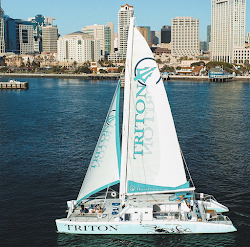On March 6, 2025, San Diego Coastkeeper and the Coastal Environmental Rights Foundation (CERF), represented by Coast Law Group, filed a Clean Water Act lawsuit against SeaWorld. The legal action alleges that the theme park has repeatedly violated its National Pollutant Discharge Elimination System (NPDES) permits by discharging untreated aquarium wastewater and fireworks debris into Mission Bay.
The environmental groups cite more than 500 days of permit violations since 2020 and present photographic evidence of plastic ignition wires, caps, and cardboard remnants scattered across Fiesta Island and on the bay floor beneath SeaWorld's fireworks barge. These pollutants, the groups argue, are laced with toxic chemicals such as barium, chromium, and copper, posing risks to human and marine health.
"SeaWorld’s flagrant violations of federal law are causing serious harm to Mission Bay’s marine environment and contradict the company’s stated mission to conserve wildlife worldwide," said Phillip Musegaas, Executive Director of San Diego Coastkeeper. "Their failure to clean up their fireworks mess and inability to properly treat aquarium water before discharging it back into the Bay must end."
The lawsuit seeks to compel SeaWorld to cease its pollutant discharges, potentially by halting or drastically reducing its fireworks shows. The park, located on leased public land, has hosted up to 150 fireworks events per year - a longstanding practice that critics say is more about extending guest spending hours than honoring public celebration. SeaWorld has not publicly responded to the lawsuit.
The suit comes just as the Port of San Diego is scrambling to save this year's Big Bay Boom - the region’s largest July 4th celebration - after new environmental requirements from the California Coastal Commission forced its longtime organizer, the Armed Services YMCA, to withdraw. The port is now taking over event planning and must conduct wildlife impact studies while exploring alternative shows such as drones or lasers beginning in 2027.
Port Commissioner Frank Urtasun warned earlier this month that these cumulative restrictions could signal the end of fireworks on San Diego’s waterfront: "This may all go away, folks … Drones are not the answer," he said.
The lawsuit seeks to compel SeaWorld to cease its pollutant discharges, potentially by halting or drastically reducing its fireworks shows. The park, located on leased public land, has hosted up to 150 fireworks events per year - a longstanding practice that critics say is more about extending guest spending hours than honoring public celebration. SeaWorld has not publicly responded to the lawsuit.
The suit comes just as the Port of San Diego is scrambling to save this year's Big Bay Boom - the region’s largest July 4th celebration - after new environmental requirements from the California Coastal Commission forced its longtime organizer, the Armed Services YMCA, to withdraw. The port is now taking over event planning and must conduct wildlife impact studies while exploring alternative shows such as drones or lasers beginning in 2027.
Port Commissioner Frank Urtasun warned earlier this month that these cumulative restrictions could signal the end of fireworks on San Diego’s waterfront: "This may all go away, folks … Drones are not the answer," he said.
The debate over aerial explosions comes as nature has taken an unexpected lead role in Mission Bay’s evolving identity. Thousands of Elegant Terns - endangered migratory birds - have returned to Mission Bay for nesting season, adding new urgency to concerns about aerial noise and disruption.
This year, an estimated 15,000 Elegant Terns have nested on the island, which now hosts about one-quarter of the species' global population. The birds are highly sensitive to disturbances, and conservationists warn that abrupt sounds like fireworks can send adults into panic flights, leaving vulnerable chicks behind.
In 2024, fireworks set off over Mission Bay on the Fourth of July were linked to the destruction of dozens of tern nests, according to the San Diego Bird Alliance. The same group has filed public comments demanding tighter restrictions on fireworks to protect nesting birds.
Residents in nearby Crown Point and Pacific Beach have noted the return of the terns - often by sound. The shrill calls of thousands of seabirds have become a regular backdrop in the area, from morning to night, delighting some bird lovers but drawing complaints from homeowners unaccustomed to the noise. Despite mixed neighborhood reactions, wildlife advocates stress that the terns’ decision to nest in Mission Bay indicates the area’s importance as one of the last viable habitats for the species.
SeaWorld’s fireworks practices, already criticized for pollution and noise, are now under legal scrutiny that could curtail the shows altogether. Environmental groups argue that SeaWorld could replace traditional fireworks with modern alternatives, like drone shows, which the park has previously tested.
As the lawsuit moves forward, fireworks shows across San Diego - from nightly summer bursts at SeaWorld to the region's marquee Independence Day celebration - may face increased regulation, or even extinction, in the name of environmental stewardship. For now, one thing is clear: as Elegant Terns return in noisy flocks and courts take up the case against SeaWorld, the summer skies over Mission Bay may soon look and sound very different.
This year, an estimated 15,000 Elegant Terns have nested on the island, which now hosts about one-quarter of the species' global population. The birds are highly sensitive to disturbances, and conservationists warn that abrupt sounds like fireworks can send adults into panic flights, leaving vulnerable chicks behind.
In 2024, fireworks set off over Mission Bay on the Fourth of July were linked to the destruction of dozens of tern nests, according to the San Diego Bird Alliance. The same group has filed public comments demanding tighter restrictions on fireworks to protect nesting birds.
Residents in nearby Crown Point and Pacific Beach have noted the return of the terns - often by sound. The shrill calls of thousands of seabirds have become a regular backdrop in the area, from morning to night, delighting some bird lovers but drawing complaints from homeowners unaccustomed to the noise. Despite mixed neighborhood reactions, wildlife advocates stress that the terns’ decision to nest in Mission Bay indicates the area’s importance as one of the last viable habitats for the species.
SeaWorld’s fireworks practices, already criticized for pollution and noise, are now under legal scrutiny that could curtail the shows altogether. Environmental groups argue that SeaWorld could replace traditional fireworks with modern alternatives, like drone shows, which the park has previously tested.
As the lawsuit moves forward, fireworks shows across San Diego - from nightly summer bursts at SeaWorld to the region's marquee Independence Day celebration - may face increased regulation, or even extinction, in the name of environmental stewardship. For now, one thing is clear: as Elegant Terns return in noisy flocks and courts take up the case against SeaWorld, the summer skies over Mission Bay may soon look and sound very different.
Originally published on April 20, 2025.

























